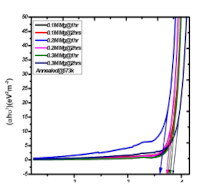INTERDEPENDENCE OF DEPOSITION TIME, DOPING CONCENTRATION, AND ANNEALING ON THE OPTICAL BEHAVIOR OF MG-DOPED ANTIMONY SULPHIDE (Sb2S3) THIN FILMS.
DOI:
https://doi.org/10.60787/jnamp.v67i2.364Keywords:
Dopant, Band gap, Chemical bath, Deposition, Antimony SulphideAbstract
Mg-doped antimony sulphide (Sb2S3) thin films were deposited on glass substrates via chemical bath deposition at room temperature, with deposition times of 60 and 120 minutes. Post-deposition, films were annealed at 100°C, 200°C, and 300°C for 60 minutes. Optical properties, assessed using a UV-Vis spectrophotometer (200-1000 nm range), reveal significant influences of deposition time, Mg concentration, and annealing temperature on absorbance, refractive index, and bandgap energy. Films deposited for 120 minutes show higher refractive indices and initial bandgap energies, decreasing more upon annealing than 60-minute films. Increased Mg concentration and higher annealing temperatures enhance refractive indices and cause a red shift, reducing the bandgap energy. Bandgaps range from 3.61 to 3.91 eV, indicating potential for high-power electronics applications. This study underscores the importance of deposition time, doping concentration, and annealing temperature in tailoring Mg-doped Sb2S3 thin films for optical devices.
Downloads
References
Radzwan, A., Lawal, A., Shaari, A., Chiromawa, I. M., Ahams, S. T., & Ahmed, R. (2020). First-principles calculations of structural, electronic, and optical properties for Ni-doped Sb2S3. ComputationalCondensedMatter, 24,e00477. https://doi.org/10.1016/j.cocom.2020.e00477
Chen, W., Zhang, J. Z., & Joly, A. G. (2004). Optical properties and potential applications of doped semiconductor nanoparticles. Journal of nanoscience and nanotechnology, 4(8), 919-947. https://doi.org/10.1166/jnn.2004.142
Pei, K. (2022). Recent advances in molecular doping of organic semiconductors. Surfaces and Interfaces, 30, 101887. https://doi.org/10.1016/j.surfin.2022.101887
Mavukkandy, M. O., McBride, S. A., Warsinger, D. M., Dizge, N., Hasan, S. W., & Arafat, H. A. (2020). Thin film deposition techniques for polymeric membranes–A review. Journal of membrane science, 610, 118258. https://doi.org/10.1016/j.memsci.2020.118258
Carlsson, J. O., & Martin, P. M. (2010). Chemical vapor deposition. In Handbook of Deposition Technologies for films and coatings (pp. 314-363). William Andrew Publishing. https://doi.org/10.1016/B978-0-8155-2031-3.00007-7
Min, H. S., Saha, D., Kalita, J. M., Sarma, M. P., Mukherjee, A., Ezekoye, B., & Pathak, T. K. (2020). Nanostructure Thin Films: Synthesis and Different Applications. In Functionalized Nanomaterials I (pp. 71-82). CRC Press.
Christian, N. I., Ekuma, A. P., & Osondu, N. (2022). Phytochemical, Optical and FTIR Studies of ZnSe Thin Films for Solar Energy Applications. IOSR Journal of Applied Physics (IOSR-JAP), 14(01), pp. 25-29. https://www.iosrjournals.org/iosr-jap/pages/v14(1)Series-3.html
Nasr, T. B., Maghraoui-Meherzi, H., Abdallah, H. B., & Bennaceur, R. (2011). Electronic structure and optical properties of Sb2S3 crystal. Physica B: Condensed Matter, 406(2), 287-292. https://doi.org/10.1016/j.physb.2010.10.070
Salem, A. M., & Selim, M. S. (2001). Structure and optical properties of chemically deposited Sb2S3 thin films. Journal of Physics D: Applied Physics, 34(1), 12. https://iopscience.iop.org/article/10.1088/0022-3727/34/1/303/meta
Sun, Q., Fassl, P., Becker‐Koch, D., Bausch, A., Rivkin, B., Bai, S., & Vaynzof, Y. (2017). Role of microstructure in oxygen induced photodegradation of methylammonium lead triiodide perovskite films. Advanced Energy Materials, 7(20), 1700977. https://doi.org/10.1002/aenm.201700977
ISHIWU, S., NWORIE, I., AGBO, P., OJOBEAGU, A., OTAH, P., & ELEKWA, C. (2024). Distinguishing Traits of Thin Films of Antimony-Doped Cadmium Selenide (Cdse/Sb) On Glass Substrate Versus Fluorine Tin Oxide (Fto) Through Spray Pyrolysis: An Investigative Analysis. Global Journal of Pure and Applied Sciences, 30(1), 115-118. https://www.ajol.info/index.php/gjpas/article/view/267570
Abdin, Z. U., Alnasir, M. H., Khan, M. Y., Sajjad, M., Qureshi, M. T., Ullah, A., & Zeb, A. (2019). EFFECT OF Fe DOPANT ON PHYSICAL PROPERTIES OF ANTIMONY SULPHIDE (Sb2S3) THIN FILMS. Chalcogenide Letters, 16(1). https://www.chalcogen.ro/37_AbdinZU.pdf
EZEMA, F. I.; EKWEALOR, A. B. C.; and OSUJI, R. U. (2006) "Effect of Thermal Annealing on the Band GAP and Optical Properties of Chemical Bath Deposited ZnSe Thin Films," Turkish Journal of Physics: Vol. 30: No. 3, Article 3. https://journals.tubitak.gov.tr/physics/vol30/iss3/3/
Nwofe, P. A., & Chukwu, J. N. (2017). Optimisation of doped antimony sulphide (Sb2S3) thin films for enhanced device applications. Journal of Nano-and Electronic Physics, 9(5). http://doi.org/10.21272/jnep.9(5).05007
Srikanth, S., Suriyanarayanan, N., Prabahar, S., Balasubramanian, V., & Kathirvel, D. (2011). Structural and optical properties of chemical bath deposited Sb2S3 thin films. Adv. Appl. Sci. Res, 2(1), 95-104. http://www.pelagiaresearchlibrary.com/
Maghraoui-Meherzi, H., Nasr, T. B., Kamoun, N., & Dachraoui, M. (2010). Structural, morphology and optical properties of chemically deposited Sb2S3 thin films. Physica B: Condensed Matter, 405(15), 3101-3105. https://doi.org/10.1016/j.physb.2010.04.020
Khan, T. M., & BiBi, T. (2012). Compatibility and optoelectronic of ZnSe nano crystalline thin film. Chinese Physics B, 21(9), 097303. DOI 10.1088/1674-1056/21/9/097303 https://iopscience.iop.org/article/10.1088/1674-1056/21/9/097303/meta

Downloads
Published
Issue
Section
License
Copyright (c) 2024 The Journals of the Nigerian Association of Mathematical Physics

This work is licensed under a Creative Commons Attribution-NonCommercial-ShareAlike 4.0 International License.




